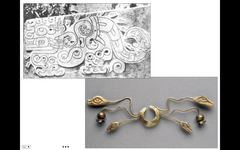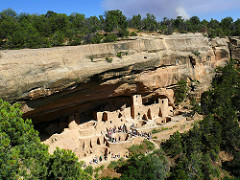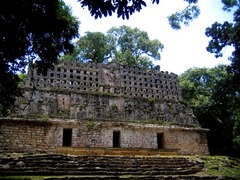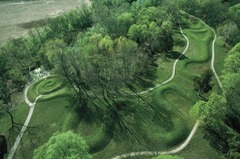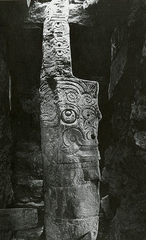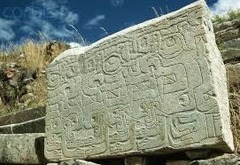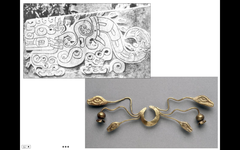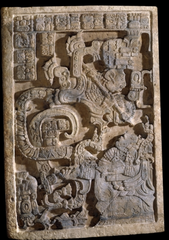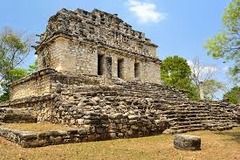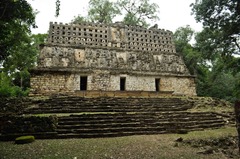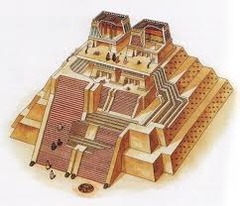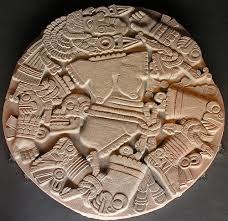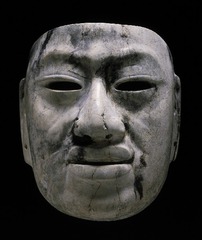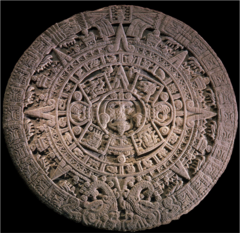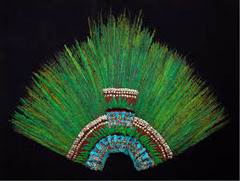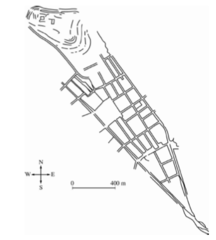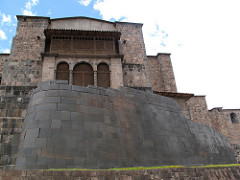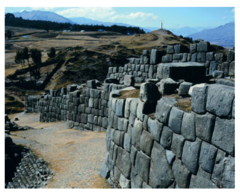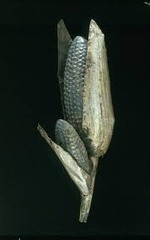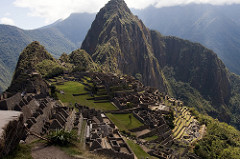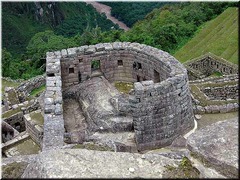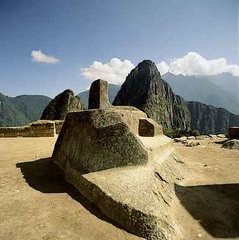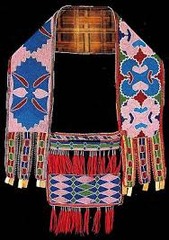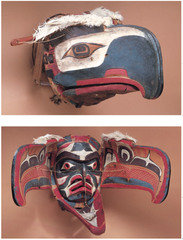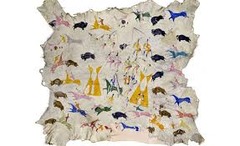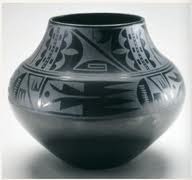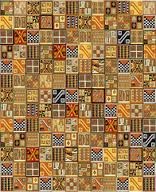Chavín de Huántar. Northern highlands, Peru. Chavín. 900-200 B.C.E. Stone (architectural complex); granite (Lanzón and sculpture); hammered gold alloy (jewelry).
-A religious capital
-temple was 60 meters tall adorned by a jaguar sculpture, a symbol of power
-hidden entrance to the temple led to stone corridors
Mesa Verde cliff dwellings. Montezuma County, Colorado. Ancestral Puebloan (Anasazi). 450-1300 C.E. Sandstone.
-Pueblo people built communities into the sides of these mountains, and accessed them by ladders
- families lived in architectural units called kivas, which were circular rooms with a fire pit in the middle
-there is a random tower
- there is also artwork and murals within the area
- the set up possible could've provided protection against outside elements, but was probably abandoned after droughts.
Yaxchilán. Chiapas, Mexico. Maya. 725 C.E. Limestone (architectural complex).
Great Serpent Mound. Adams County, southern Ohio. Mississippian (Eastern Woodlands). c. 1070 C.E. Earthwork/ effigy mound.
-largest serpent mound in the world. most other mounds were destroyed by hopeful farmers.
-both agricultural and architectural
-snake believed to be holy, containing supernatural powers. They were used in rituals
- head points to summer solstice, whereas the tail points to the winter one.
- may have been a representation of an astronomical event such as a comet or supernova
- built by either the Fort Ancients, or refurbrished by them
Lanzon Stela. Granite
-inside the old temple of Chavin there is a maze like system of hallways
-at the center is this stone
-its 15 feet tall and blade shaped
- depicts a powerful figure that is part human and part animal
- flat relief; designs in curvilinear pattern
- served as a cult figure
- a center of pilgrimage
Relief sculpture. Granite.
- located at the Chavin de Huantar ruins
- shows jaguar in shallow relief
Nose Ornament. Hammered gold alloy
- worn by men and women
- held in place by the semi-circle
- two snake heads
-makes the wearer into a supernatural being during ceremonies
Lintel 25, structure 23, Yaxchilan, 725, limestone.
- lintel originally set above the central doorway
- building dedicated to lady xoc
- she holds a bowl with bloodletting ceremonial items: stinging spine and bloodstained paper
-vision serpent has two heads: one has a warrior emerging from its mouth; the other has tlaloc, a war god.
- inscription written as a mirror image-- extremely unusual in Mayan script; uncertain meaning, perhaps indicating she has a vision from the other side of existence, and she is acting as an intercessor or shaman
Structure 40. Yaxchilan, Mexico.
-Yaxchilan was a city set upon a high terrace and flourished between 300-800
-this structure was built by Bird Jaguar IV, or his on who dedicated it to him
- three central doors leading to a central room
- large roof comb
Structure 33. Yaxchilan, Mexico.
-restored temple structure
-remains of roof combf and perforations
-three central doorways lead to a single room
-corbel arch interior
Templo Mayor (Main Temple). Tenochtitlan. Aztec. 1375-1520. Stone (temple). Volcanic Stone (The Coyolxauhqui Stone); jadeite (Olmec-style mask); basalt (Calendar Stone).
-90 steps on north side and 91 on other sides with two temples on top
-Tlaloc (rain deity) and Huitzilopochtili (warfare, fire, and sun)
-aligned with summer/winter solstices
-shadows looked like serpent slithering across temple
- Serpents, heads, and stones at the step entrance
The Coyolxauhqui stone "She of the Golden Bells"
-story of goddess Coyolxauhqui
- low relief
- chaos
-severed body parts/dismembered
- placed at the base to transform the temple into the snake mountain
- name because of the bells she wears as earrings
- sacrificed people were thrown down the steps to be dismembered and become like Coyolxauhqui
- once painted with bright colors
Olmec style mask
- found by the Aztec, and because of its ancient origins, it was believed to be precious and historic
- has a characteristic frown, pugnacious visage, heavy lidded eyes, and suggested headgear
Calendar stone
-it was the conception of time for the Aztec
- In the center there is the image of the Fifth Sun, Nahui Olin or Four Movement and the face of Tonatiuh, god of the Sun, with the particular representation of having only the lower half of the face fleshless and the upper part normal, which symbolizes life and death
-The mythology is that life has gone through different eras of creation and destruction
- placed on the floor on the temple site
-its multiple rings symbolize different things
- used as an alter to sacrifice people
- tongue in the center of the stone coming from the god's mouth was a sacrificial flint knife used to slash open the victims
Ruler's feathered headdress (probably of Motecuhzoma II). Aztec. 1428-1520. Feathers and gold.
-worn probably by one of the latest Aztec kings, and given to Ferdinand II as a gift
- still in Austria
- This headdress was used by Aztec royalty for
ritualistic purposes, especially to be worn when impersonating the god Quetzalcoatl.
- 400 long green feathers, 400 symbolized eternity
City of Cusco. Inka. 1440; consent added 1550-1650. Andesite
- capital of the Inkan empire
- in the shape of a puma
- the plaza is where the puma's belly would be
- at the head there was a fortress and at the heart was the central square
Curved Inka wall of Qorikancha with Santa Domingo convent
- remains of the incan temple of the sun
- form the base of a really old convent called Santa Domingo
- Original exteriors decorated in gold to symbolize sunshine
- Qorikancha: a golden enclosure; once was the most important temple
- used as an observatory for priests to chart the skies
- said to have been entirely covered in gold
- walls taper upward; examples of inkan trapezoidal architecture
Walls at Saqsa Waman
- complex outside Cusco
-ashlar masonry
- contains stones of up to 70 tons, taken from a quarry two miles away
Maize cobs. Inka. 1400-1533 C.E. Sheet metal/repousse, metal alloys.
- maize was the primary food source
- the oxidized silver reflects the common black maize
- used to ensure a successful harvest
- repousse technique
Machu Picchu. Central highlands, Peru. Inka. 1450-1540. granite.
- originally functioned as a royal retreat for 15th century Inkan rulers
- so remote, it probably wasn't used for any administrative purposes
- perfect stone cuts to keep everything together
- two hundred buildings, mostly houses
- farmland on terraces
Observatory in Machu Picchu
-used to chart suns movement
-good vantage point in mountains/between peaks
- ashlar masonry
Intihuatana Stone
-hitching post of the sun
- aligns with the sun during spring and autumn equinoxes, when the sun stands directly over the pillar, creating no shadow.
- this event was celebrated
Bandolier bag. Lenape (Delaware tribe, Eastern Woodlands) 1850. Beadwork on leather.
-there are thousands of beads strung in this set up
-used as ceremonial and decorative, not necessarily utilizing the pocket to carry stuff
- large and decorated with a lot of color
- even after they were displaced, they continued to make this kind of stuff
- abstract and symmetrical
Transformation mask. Kwakwaka'wakw, Northwest coast of Canada. Late 19th century. Wood, paint, and string.
-ceremonial and worn during dances
-represents and animal, and when the string is pulled, the animal (in this case a bird) changes (in this case the beak splits in half representing the wings), and becomes something else entirely, whether that be a deity, ancestor, or human.
-Kwakwakawakw were in British Columbia and were separated in numayan (clans), which were responsible for the rights and ranks of the clan
Painted elk hide. Attributed to Cotsiogo (Cadzi Cody), Eastern Shoshone, Wind River Reservation, Wyoming. 1890-1900. Painted elk hide.
-painting on hides was always practiced
- usually used geometrical shapes and imagery motifs
- the artist, Cadzi Cody, lived on a reservation and likely included these scenes cause they were tourist friendly
Black-on-black ceramic vessel. Maria Martinez and Julian Martinez, Tewa, Puebloan, San Ildefonso Pueblo, New Mexico. mid-20th century. Blackware ceramic.
-black on black vessels
-highly polished surfaces
-contrasts of shiny and black and matte black finishes
-comes from the 1000 year old tradition of pottery making in the southwest
-at the time pueblos were in decline, with modern life replacing traditional
-Their work sparked a revival of the techniques
- Maria made them and Julian painted them
-exceptional symmetry
All-T'oqapu tunic. Inka. 1450-1540. Camelid fiber and cotton.
- rectangular, with slit head
- composition of small squares called t'oqapu
- individual t'oqapu might be symbolic of people, events, or places
- wearing a tunic like this would represent wealth
- exhibits Inkan preference for abstract designs, standardization of designs, and an expression of unity and order.
